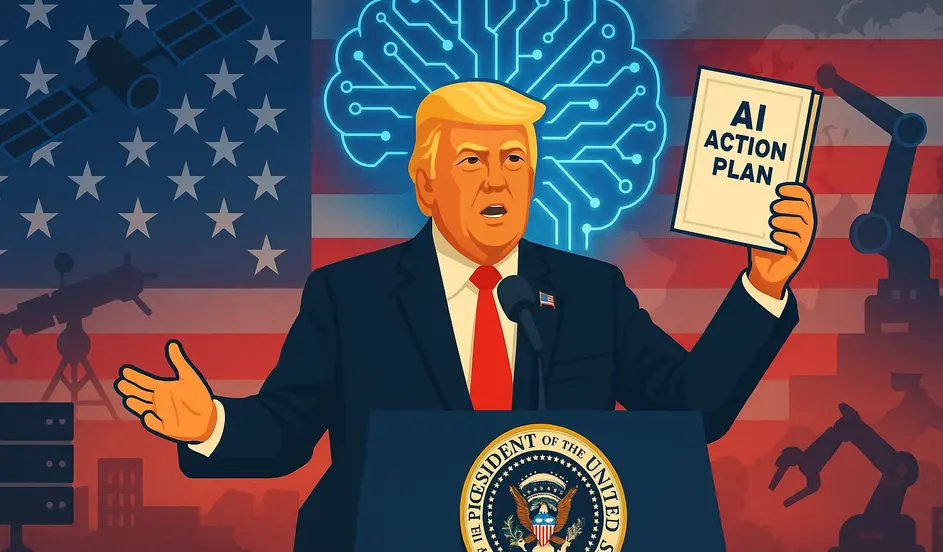In a fiery speech aimed at the heart of America’s technology sector, Donald Trump unveiled what he called the White House AI Action Plan, a sweeping roadmap designed to cement the United States as the global leader in artificial intelligence. The announcement, delivered with Trump’s signature style, targeted tech companies that have “reaped the blessings of American freedom while building factories in China, hiring workers in India, and slashing profits in Ireland.”
The message was unmistakable: the era of outsourcing is over, and the future of AI must be built in America.
The America-First Tech Agenda
Trump criticized decades of what he described as “radical globalism” in the tech industry, which he argued betrayed American workers and weakened U.S. competitiveness.
“We need U.S. technology companies to be all-in for America. We want you to put America first. You have to do that. That’s all we ask,” he declared.
The plan marks a sharp pivot from a model where American tech giants spread operations across Asia and Europe. Instead, it pushes for domestic innovation hubs, semiconductor plants, and new energy infrastructure to power the data centers required for advanced AI.
Building the World’s Largest AI Infrastructure
At the heart of the AI Action Plan is an ambitious promise: to build and maintain the largest and most advanced AI infrastructure on the planet.
Trump laid out a vision that includes:
- New semiconductor and chip manufacturing facilities across the U.S.
- Expansive data centers to handle growing AI workloads.
- Energy investments, including new power plants and transmission lines, to support AI’s enormous electricity demand.
- Private-sector leadership, with the government’s role focused on cutting red tape and streamlining approvals.
Trump emphasized that these projects would primarily be financed by private capital but require Washington to “get out of the way.”
Cutting Red Tape: The Deregulation Doctrine
A central pillar of the plan is rolling back regulations that Trump argues have stifled U.S. competitiveness.
He repeated his signature policy that for every new regulation, 10 old ones must be eliminated:
“For too long, innovators were strangled with red tape so they couldn’t move, so they couldn’t breathe. Under my leadership, that’s not going to happen.”
He linked regulatory delays to his own real estate background, recalling zoning approvals that took years, often by which time market conditions had changed. Trump promised that AI infrastructure projects would not face similar hurdles.
Challenging Big Tech’s Global Model
Trump’s speech carried sharp criticism of Silicon Valley giants that have grown global while “censoring fellow citizens at home.”
He accused these companies of chasing profits abroad while neglecting U.S. workers, arguing that his administration would hold them accountable.
The underlying message: AI should not only be developed in America but also serve America’s workers and economy first.
Invest in America’s Workforce
Post your job on WhatJobs and connect with U.S. professionals ready to drive innovation, strengthen the economy, and keep tech talent at home.
Post a Job Now →Global Tech Rivalry: China, India, and Ireland
The announcement comes at a time of intensifying global competition over AI.
- China has poured billions into AI development, aiming for leadership by 2030.
- India has positioned itself as a hub for skilled AI labor.
- Ireland has long been a tax haven for U.S. tech companies.
By calling out these countries directly, Trump framed the AI race not only as a technological contest but also as a geopolitical battle where America cannot afford to fall behind.
Jobs and Economic Impact
One of the strongest themes in the speech was jobs. Trump linked the AI Action Plan to new employment opportunities for American workers, from construction of factories to roles in engineering, energy, and data management.
However, critics note that AI automation itself could threaten millions of jobs, particularly in white-collar sectors. Trump’s plan does not yet detail how displaced workers might be retrained or protected, though his rhetoric emphasized building rather than outsourcing.
Still, large-scale infrastructure investments could deliver immediate boosts in construction jobs, advanced manufacturing, and skilled tech labor within the U.S.
Environmental Concerns vs. Industrial Growth
Trump addressed environmental protections briefly, noting projects would be carried out “with environmental protection and all of the things that we have to do to get it done properly.”
This statement may not quiet critics who argue that rapid expansion of data centers and power plants risks higher carbon emissions unless paired with renewable investments. Tech giants like Google and Microsoft have pledged carbon neutrality, but whether Trump’s plan aligns with those goals remains unclear.
Industry Reaction
While the speech was heavy on vision, it left questions about implementation. How quickly can semiconductor plants be built? How will energy grids adapt? And will Big Tech buy into an America-first strategy when their profits depend on global markets?
Some industry leaders welcomed the deregulation push, saying it could accelerate stalled projects. Others worry the emphasis on domestic-only priorities could create trade conflicts or limit access to global talent.
Trump’s Political Messaging
The rollout of the AI Action Plan also carried unmistakable political undertones.
Trump framed himself as the defender of American workers against globalist elites, positioning AI not just as a technology challenge but as a cultural and economic battle.
This framing will likely resonate with voters concerned about job security, foreign competition, and Big Tech’s influence, especially ahead of upcoming elections.
Looking Ahead: America’s AI Future
The White House AI Action Plan is both ambitious and controversial. If realized, it could dramatically reshape America’s technological landscape by:
- Bringing semiconductor production back to U.S. soil.
- Creating thousands of domestic jobs.
- Positioning the U.S. as the undisputed leader in AI.
But questions remain over cost, execution, and the balance between innovation and regulation. For now, Trump’s message is clear: the AI future must be built in America, by Americans, for America.
FAQs on the White House AI Action Plan
1. What is the White House AI Action Plan?
The plan is Donald Trump’s strategy to boost U.S. leadership in artificial intelligence through infrastructure investment, deregulation, and America-first policies.
2. How does it affect U.S. jobs?
The plan could create construction, manufacturing, and tech jobs in the short term, though concerns remain about long-term automation impacts.
3. Why did Trump criticize China, India, and Ireland?
He argued that U.S. tech companies outsourced too much to these countries—manufacturing in China, labor in India, and tax benefits in Ireland—while neglecting U.S. workers.
4. What role does deregulation play in the plan?
Trump pledged that for every new regulation, 10 old ones would be removed, aiming to fast-track approvals for factories, data centers, and power plants.
5. Will private companies or the government fund these projects?
Trump said the private sector will finance most projects, with government action focused on clearing regulatory roadblocks.
6. How does this compare to global AI strategies?
China is heavily state-driven, Europe emphasizes regulation, and Trump’s plan leans on deregulation and private-sector leadership.
7. What are critics saying?
Skeptics warn about environmental risks, global trade conflicts, and lack of worker protection from automation.
8. When will the plan be signed?
Trump teased signing it “right after this speech,” signaling urgency, though specific implementation timelines are not yet public.
Final Thoughts
Trump’s AI Action Plan blends bold infrastructure promises with sharp populist messaging. Whether it becomes a transformative blueprint or another ambitious pledge will depend on execution, private-sector buy-in, and the balance between America-first politics and global economic realities.
For now, one thing is certain: the AI race has become a central battleground not only for technology but also for America’s political future.




